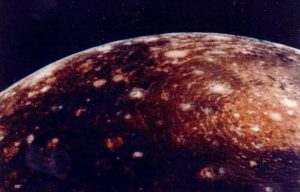Huge amounts of oxygen discovered on Jupiter’s moon

 One of Jupiter’s many moons, Callisto, may contain much more oxygen than scientists expected, according to recent research. This discovery raises many questions and could change our understanding of this mysterious moon of Jupiter.
One of Jupiter’s many moons, Callisto, may contain much more oxygen than scientists expected, according to recent research. This discovery raises many questions and could change our understanding of this mysterious moon of Jupiter.
Callisto, despite its status as the second largest moon of Jupiter and the third largest in the solar system, has always remained hidden in the shadow of its neighbors such as Europa and Ganymede, which have attracted the attention of scientists with their mysterious underground oceans and giant jets of water.
Callisto is distinguished by its ancient surface, believed to be the oldest in the solar system, and many researchers suggest that an ocean may lie beneath its thick crust. However, for a long time it did not attract much scientific interest, and NASA missions usually avoided it.
However, recent studies have shown that this moon contains much more oxygen than expected.
The researchers decided to study the effect of intense plasma in Jupiter’s magnetosphere on its icy moons, including Callisto. They conducted experiments in which they measured the release of water molecules from low-temperature ice caused by falling charged particles, a process called sputtering.
“The results showed that water ice sputtering is dominated by electronic excitations and ionizations occurring in the ice (electron sputtering) rather than by detonation collisions of ions with water molecules (nuclear sputtering), a sputtering process hitherto commonly studied,” the researchers said.
Further experiments led to a surprising discovery: the bonds in water ice molecules can be dissociated by the electron energy released by falling charged particles, and the fragmented molecules can recombine to form new species, such as H2 and O2.
The most surprising thing was that the amount of oxygen detected on Callisto was much greater than expected. This caused confusion among scientists, since existing models could not explain such high oxygen levels on Jupiter’s moon.
Lead study author Shane Carberry Maughan said: “There is a huge discrepancy. We are behind by about two or even three orders of magnitude.”
Even if Callisto were completely covered in ice, and not just 10 percent as the team had assumed, this would still not explain the amount of oxygen. Scientists have proposed several hypotheses, but none of them provide a satisfactory explanation.
This discovery challenges our understanding of the origin and composition of Jupiter’s moons. Perhaps answers to these questions will be found during the upcoming JUICE (JUpiter ICy moons Explorer) mission, which will fly around the icy moons of Jupiter.
Scientists hope that this mission will be able to provide “multipoint parallel measurements of the charged and neutral particle environment of the moon,” which may help solve the mystery of the presence of huge amounts of oxygen on Callisto.




